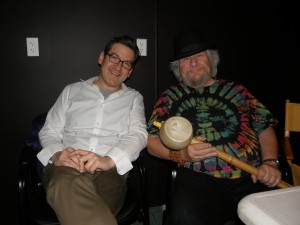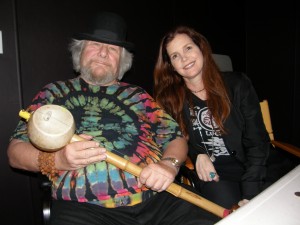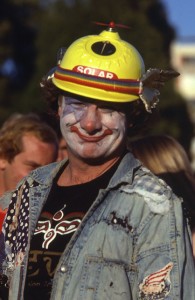
Wavy Gravy — counterculture icon, court jester of the war protest movement, clown emcee of Woodstock, one of Ken Kesey’s original Merry Pranksters and King Hippie of The Hog Farm —was visiting the West Village recently. The man once long ago known as poet Hugh Romney was helping filmmaker Michelle Esrick promote her new documentary “Saint Misbehavin’: The Wavy Gravy Movie”.
Wavy was as mischievous and fun as ever. He was also enthusiastic to talk about his current work raising money for cataract surgery around the world and Camp Winnarainbow, the summer camp he and his wife Jahanara run.
Dressed in his usual tie-dyed T-shirt and bowler hat, he proceeded to wave a rubber fish, mounted at the end of flexible rod, in my face making the fish kiss me.
When I asked him if he thought the political work done over the Internet is as effective as getting out there on the streets like in the old days he said, “I just don’t know. It’s what’s taking place now. And now is all there is. Eternity now, I always say.”

While reading up on Wavy Gravy, it occurred to me how many of my questions would begin with the words, “Is it true…?” Like, Is it true that Lenny Bruce managed you? Is it true you shared a room with Bob Dylan over The Gaslight and that he wrote “A Hard Rain’s a-Gonna Fall” on your typewriter? I mean the list goes on and on.
“It wasn’t a private apartment, by the way,” said Wavy. “It was part of The Gaslight, upstairs. Dylan had got me to come back there and the room was part of the deal. I think we kicked Bill Cosby out of there, as a matter of fact. He was still a student at Temple, I think. I’m not sure.”
Wavy was doing spoken word at this time. “Then I began to do stand-up improvisation. Rants, I guess you could call them. Then I started doing more true stuff about my life rather than making up jokes. In fact, joke telling is definitely not my thing. True stories are what I do. And some of them are funny. Some of them are very funny,” he emphasized.
“When you laugh at stuff, your defenses go down and you’re able to hear something like ‘Nobody for President!’ Holy Smokes! And you think about it. At first it’s just a hoot. But then there’s an owl behind that hoot.”
What I learned from watching the documentary is that the Wavy of today is as relevant as he was back in the ’60s. Not only because we need peace in the world now more than ever but also because of the practical work he’s doing with the Seva Foundation and fundraising for cataract surgeries all around the world.
Esrick said, “Someone wrote to me today and said, ‘I saw your film and every bit of cynicism drained out of my body.’ I find when I’m around Wavy, I’m able to hear more clearly and I’m able to see a little more clearly. Bob Weir [founding member of the Grateful Dead] says when he’s around Wavy everything just comes into focus.”
In making the film Esrick says she learned a lot about Wavy, but about herself, too. “I had to give birth to myself many times over to make this film. It was very hard,” she admitted.
 “One thing I am good at is calling up people I admire, like D.A. Pennebaker [co-director of “Don’t Look Back” and the recent “King of Pastries,” who served as executive producer on the film], and asking them to mentor me. He said yes for some reason, and we became very close. I pay attention to what the universe puts in front of me,” Esrick added.
“One thing I am good at is calling up people I admire, like D.A. Pennebaker [co-director of “Don’t Look Back” and the recent “King of Pastries,” who served as executive producer on the film], and asking them to mentor me. He said yes for some reason, and we became very close. I pay attention to what the universe puts in front of me,” Esrick added.
And what did she learn about Wavy? “Well, he has been married to a wonderful woman for 45 years. I asked a lot of people that in interviews, what did Wavy teach you. I love what Bob Weir said: ‘It’s not what he taught me, but that he affirmed what I already knew.’ I already felt in my heart that it’s all about service to others. About being useful.”
Esrick also comes from a background of progressive activism. “One of the reasons why I want “Saint Misbehavin’” to succeed is so people can come together and watch it as a community,” she said. “I mean, I can stay on my computer all day.”
The Facebook page for the movie already has 8,000 fans. “It’s a wonderful and effective way to communicate with people around the world,” she said. “But in terms of really connecting with people, it’s not the same. I know I really grow as an artist when I am around other artists. I can only spend so much time alone when I’m creating in my apartment. But when I get together with other artists, it really fuels me.”
And what did Wavy learn being the subject of a documentary? “It was just so wonderful seeing the next generation of kids on camera,” he said. “There was a moment where one of the kids we took into our family repeated a line that I taught him — it makes it into the movie. It’s from Ken Kesey: ‘Always put your good where it will do the most.’ I saw this youngster saying it, and I found myself re-affirming myself, if that makes any sense.”
Article originally appeared: http://www.westviewnews.org/cms/articles/1038-documentary-re-affi-rming-wavy-gravy

